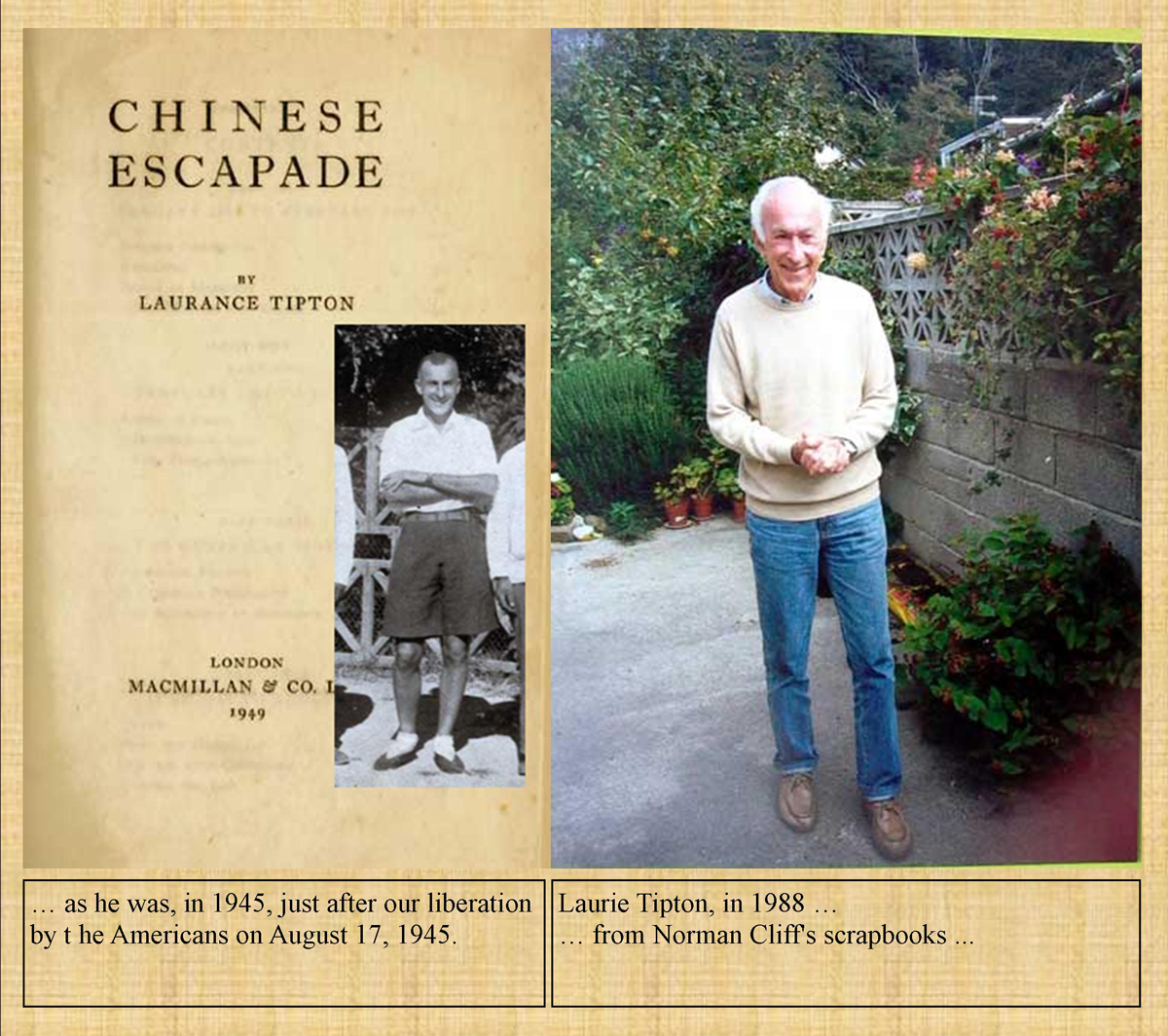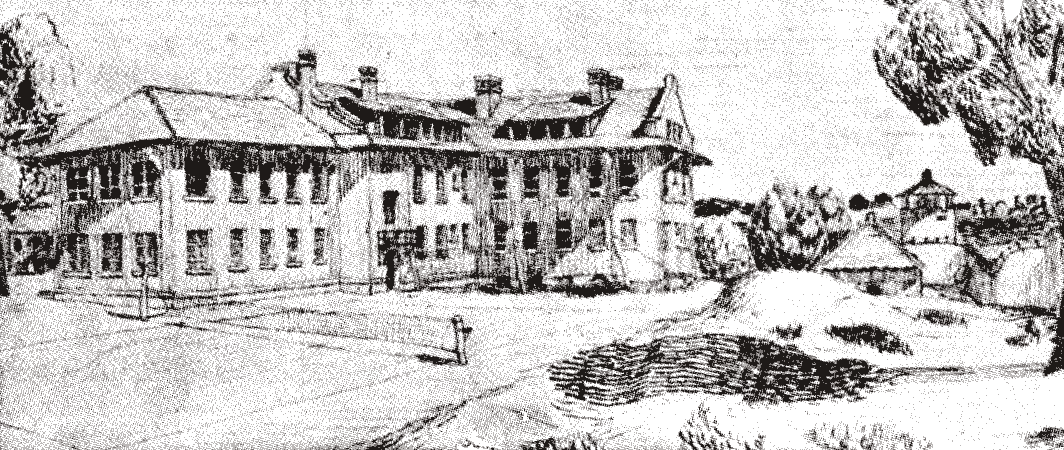
- by Laurance Tipton
[Excerpts] ...

[...]
The whole compound could be divided into three sections.
The numerous alleys consisting of rows of students’ rooms housed the married people, the women and a few of the more fortunate bachelors, and scattered amongst the students quarters were the class-rooms which had been turned into dormitories for the single men.
On the east section of the compound was the hospital, surrounded by open ground on which had once been a tennis court and a basketball pitch.
Divided by a wall from these two sections were seven or eight large western-style houses which in former days had been occupied by the mission faculty and were now housing the Japanese camp staff and guards.
A few were unoccupied and it was from these that flowed the endless assortment of knickknacks which gave a homelike appearance to our bare cabins.
Before lunch we had succeeded in scrounging two cupboards and a table, and by supper-time that night we were comparatively well-furnished, having found two wooden chairs, a kettle, an enamel boiler, a bucket and a fine selection of glass preserving jars. By the end of the first week we had put up the beds, and nailed a few shelves to the walls, but by the end of a month we had a double-decker sleeping-berth, which left room for a couple of chairs and a collapsible writing-desk. We spread a rug on the floor, hung curtains at the windows and built an outside cooking stove against the next row of tenements.
The camp was in an appalling state: many of the buildings, including the hospital, were littered with filth to a depth of several feet; sanitary arrangements had not been completed ; there was rubbish everywhere.
No preparations had been made for the first arrivals, a group of British and Americans from Tsingtao. The American party from Peking had arrived before their beds and bedding, and had spent the first two nights on the floor with nothing more, for the most part, than overcoats and one blanket each.
It had snowed and had rained, and the compound became a perfect quagmire. Hot water was scarce and food supplies negligible, the most unappetising mess being served twice a day, under the alias of “stew”, by the Tsingtao pioneers.
There were three centres for the preparation of food, known as the Tsingtao, Tientsin and Peking kitchens. By the time the Peking British arrived the Americans had brought some semblance of order to the Peking kitchen.
Within a few weeks the camp began to organise itself, and committees were formed which took the responsibility of seeing that the necessary jobs were done. Soon life had settled down to a well-organised routine.

[excerpt]
After the escape: June 8, 1944 ...
Regular communications with the camp had been established, but, anxious not to take undue risks, we restricted these contacts as much as possible and all messages exchanged between us were in code.
We made use of a man who was employed by the Japanese as a camp carpenter. Our communications were written on the finest silk, folded into a small pellet and wrapped in contraceptive rubber. In order to take one of these into camp, the carpenter would place the pellet up his nose or hold it in his mouth, and, having entered the camp, he was closely followed by de Jaegher or Roy Tchou, who anxiously waited for him either to blow his nose or spit.
The return message, written on a piece of Mrs. Tchou’s discarded silk undies, was concealed in the same manner.
On one occasion when the Japanese guard asked our messenger to open his mouth, he had to swallow the pellet. Unable to bring it up again, he got Roy into a secluded corner, confessed the trouble, and grudgingly agreed to wait while Roy rushed over to the hospital for a little harmless medicine to assist him.
He returned with about a third of a glass of castor oil. Late that afternoon just before the gates closed, a very sorry-looking Chinese shuffled towards the gate, followed by a Japanese urging him to hurry. Passing Roy, he “hoiked”, and spat a mouthful of saliva at him, much to the amusement of the Japanese guard, who evidently took it as an expression of his contempt for the foreign devils.
[excerpt]
The Japanese, always suspicious, rarely gave him the opportunity of seeing a member of the Committee alone, much less an internee.
In order to keep him informed, reports on the camp and any special requests were prepared in advance of Egger’s visits. Upon his arrival a Japanese would escort him from the main gate to the office and en route he would be met “ casually “ by one or two of the Committee members, who, in passing through a gateway or going up the office stairs, would do a little pre-arranged hustling, during which messages were exchanged.
If this method failed, later, during the meeting that followed between the Commandant, Egger and certain members of the Committee, Ethel, who was present to take notes (usually sitting next to Egger), always managed to slip a note into his coat pocket or his attaché-case, which she sometimes used as a support for her shorthand pad.
Egger was the only official contact that the camp had with the outside world. He worked under tremendous difficulties: both he and his staff were watched very closely by the Japanese in Tsingtao and any move he made was regarded with the utmost suspicion.
On each trip to the camp he endeavoured to bring much-needed supplies.
We depended upon him to purchase the medicines and drugs for the hospital, and some-times he would be able to bring in parcels for the internees from their friends in Tsingtao. In the beginning this was not too difficult, but gradually the Japs enforced a multitude of restrictions, and special passes and permits had to be obtained.
Any official orders handed to Egger through the Committee were always carefully examined by the Japanese, who delighted in crossing off various items, particularly extra food for the hospital patients.
Sometimes he went so far as to alter and occasionally forge these permits.
[further reading]

http://www.weihsien-paintings.org/Tipton/TiptonTotale(WEB).pdf
#








